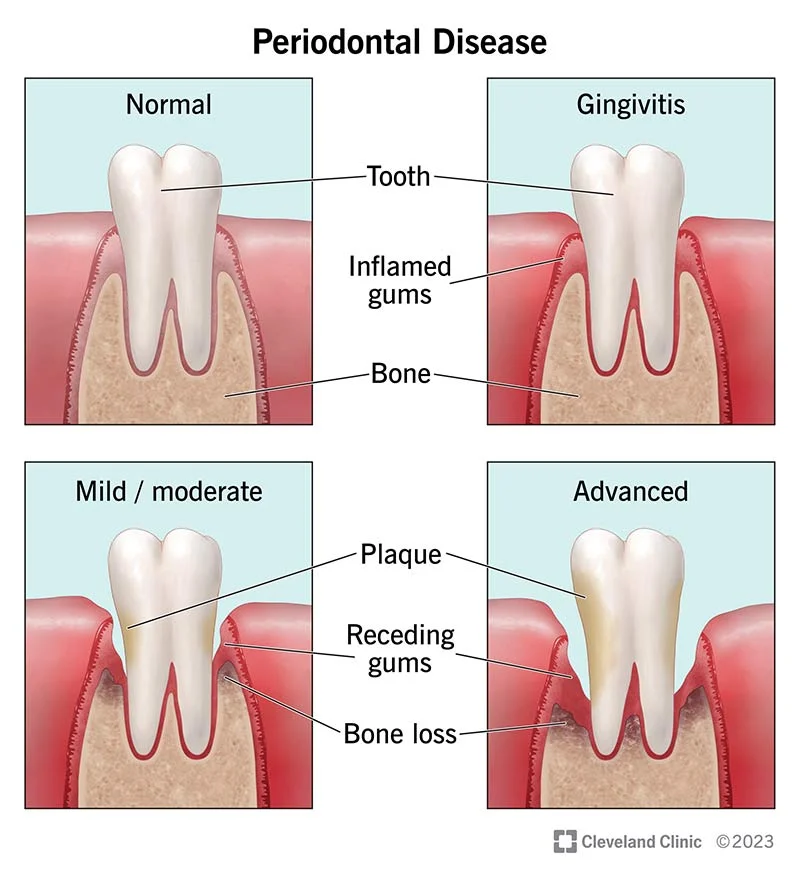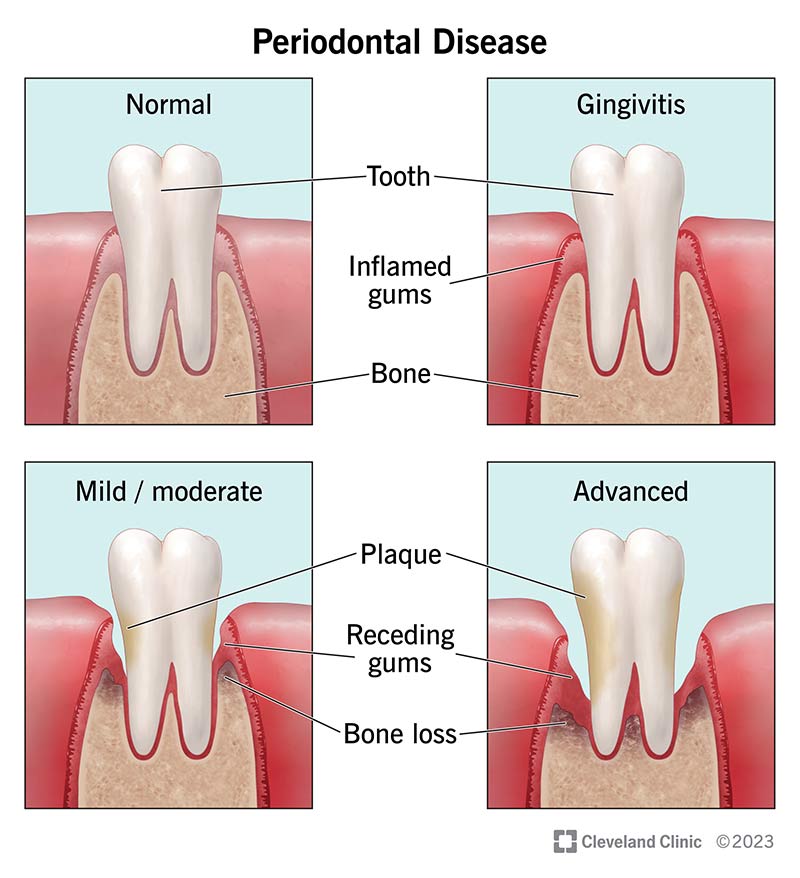
Gum disease, whether mild gingivitis or severe periodontitis, demands attention. Left untreated, it can lead to tooth loss and impact overall health. But fear not! Effective solutions exist. From rigorous oral hygiene to professional treatments, we’ll navigate the path to oral health together. With knowledge and action, you can combat gum disease and preserve your smile.
If left untreated, it can lead to tooth loss and other serious complications. So, what can you do about gum disease? Here are some steps to take:
- Brush your teeth twice a day using a soft-bristled toothbrush and fluoride toothpaste.
- Floss daily to remove plaque and bacteria from between your teeth and along the gumline.
- Visit your dentist regularly for professional cleanings and check-ups.
- Quit smoking, as it can worsen gum disease.
- Eat a balanced diet and limit sugary foods and drinks.
- Manage stress, as it can affect your oral health.
- If your gum disease is advanced, your dentist may recommend treatments such as scaling and root planing, antibiotics, or surgery.
Understanding Gum Disease and How to Take Action
Gum disease, also known as periodontal disease, is a common oral health condition that affects the gums and supporting structures of the teeth. It is caused by bacteria in plaque, a sticky film that forms on the teeth, and can lead to inflammation, infection, and even tooth loss if left untreated. While gum disease is a serious condition, the good news is that there are steps you can take to prevent and treat it. In this article, we will explore what you can do about gum disease to maintain a healthy smile.
1. Recognizing the Signs of Gum Disease
The first step in addressing gum disease is to recognize the signs and symptoms. Some common indicators of gum disease include red, swollen, or tender gums, bleeding gums when brushing or flossing, persistent bad breath, receding gums, loose or shifting teeth, and changes in your bite. If you notice any of these signs, it is important to take action promptly to prevent further damage.
Gum disease can be categorized into two stages: gingivitis and periodontitis.
Gingivitis is the early stage of gum disease and is characterized by inflammation of the gums. If left untreated, it can progress to periodontitis, which involves the breakdown of the gum tissue and underlying bone.
Regular dental check-ups can help identify gum disease in its early stages, making it easier to treat.
2. Maintaining Proper Oral Hygiene
One of the most important steps you can take to prevent and manage gum disease is to maintain proper oral hygiene.
- Brushing Twice Daily: Brush your teeth with a soft-bristled toothbrush and fluoride toothpaste at least twice a day. Ensure thorough cleaning of all tooth surfaces, including along the gumline, to remove plaque and bacteria.
- Daily Flossing: Floss daily to remove plaque and food particles from between teeth and along the gumline. This helps prevent plaque buildup and reduces the risk of gum disease and tooth decay.
- Antimicrobial Mouthwash: Use an antimicrobial mouthwash as recommended by your dentist to control bacteria and reduce plaque buildup. Mouthwashes containing chlorhexidine or other antibacterial agents can be beneficial when used according to your dentist’s instructions.
3. Adopting Healthy Lifestyle Habits
- Maintain Good Oral Hygiene: Regular brushing, flossing, and dental check-ups are essential for preventing and managing gum disease.
- Quit Smoking and Tobacco Use: These habits increase the risk of gum disease, so quitting is crucial for oral health improvement.
- Adopt a Balanced Diet: Eating fruits, vegetables, and whole grains provides essential nutrients that support gum health and overall well-being.
- Manage Stress: Stress weakens the immune system, making it harder to fight infections. Engage in stress-reducing activities like exercise, meditation, or deep breathing to support gum health.
4. Seeking Professional Dental Care
5. Embracing Additional Treatment Options
- Gum disease may necessitate extensive treatment options like gum grafts or guided tissue regeneration to restore gum health.
- Gum grafts involve taking tissue from another part of the mouth and attaching it to the gums.
- Guided tissue regeneration promotes bone and tissue regeneration.
- Your dentist will assess your condition and recommend the most suitable treatment plan.
- Gum disease is chronic, requiring ongoing maintenance and regular dental visits to prevent recurrence.
- Following your dentist’s advice and maintaining good oral hygiene habits are crucial for controlling gum disease and safeguarding oral health.
In conclusion, gum disease is a common oral health condition that requires attention and action. By recognizing the signs, maintaining proper oral hygiene, adopting healthy lifestyle habits, seeking professional dental care, and embracing additional treatment options when necessary, you can effectively manage gum disease and maintain a healthy smile. Remember, prevention is key, so take proactive steps to protect your gums and overall oral health.
Key Takeaways: What to Do About Gum Disease
- Brush your teeth at least twice a day to remove plaque buildup.
- Floss daily to clean between your teeth and along the gumline.
- Visit your dentist regularly for professional cleanings and check-ups.
- Avoid smoking and limit alcohol consumption to reduce the risk of gum disease.
- Eat a balanced diet rich in fruits and vegetables to promote gum health.
Frequently Asked Questions
Here are some commonly asked questions about gum disease and what you can do to address it.
Q1: What are the common signs and symptoms of gum disease?
Gum disease, also known as periodontal disease, can manifest in various ways. Some of the common signs and symptoms include:
1. Red, swollen, or tender gums.
2. Bleeding gums, especially during brushing or flossing.
3. Persistent bad breath.
4. Receding gums or teeth appearing longer than usual.
If you notice any of these symptoms, it’s important to consult with a dentist for an accurate diagnosis and appropriate treatment.
Q2: How can I prevent gum disease?
Preventing gum disease starts with good oral hygiene practices. Here are some tips:
1. Brush your teeth at least twice a day with a fluoride toothpaste.
2. Floss daily to remove plaque and food particles from between your teeth.
3. Use an antiseptic mouthwash to kill bacteria and freshen breath.
4. Visit your dentist regularly for professional cleanings and check-ups.
Additionally, avoiding tobacco products, maintaining a healthy diet, and managing stress can also contribute to gum disease prevention.
Q3: What treatments are available for gum disease?
The treatment for gum disease depends on the severity of the condition. Mild cases may be treated with non-surgical methods, such as:
1. Scaling and root planing: This involves deep cleaning to remove plaque and tartar from the gumline and tooth roots.
2. Antibiotics: Topical or oral antibiotics may be prescribed to eliminate bacteria and control infection.
In more advanced cases, surgical interventions like gum grafting or flap surgery may be necessary to restore gum health and reduce pocket depths. Your dentist will determine the most suitable treatment plan based on your specific needs.
Q4: Can gum disease be reversed?
While gum disease cannot be completely reversed, it can be effectively managed and controlled with proper treatment and ongoing care. The goal is to halt the progression of the disease and prevent further damage to the gums and supporting structures.
With regular dental visits, professional cleanings, and consistent oral hygiene practices at home, you can maintain healthy gums and prevent the advancement of gum disease.
Q5: Are there any home remedies for gum disease?
While home remedies cannot replace professional treatment, they can complement your efforts to manage gum disease. Here are a few remedies that may help:
1. Saltwater rinses: Gargling with warm saltwater can help reduce inflammation and kill bacteria in the mouth.
2. Oil pulling: Swishing coconut oil or sesame oil in your mouth for a few minutes may help reduce plaque and bacteria.
3. Herbal remedies: Some herbal remedies like aloe vera, tea tree oil, and chamomile may have anti-inflammatory and antibacterial properties that can support gum health.
However, it’s crucial to consult with your dentist before trying any home remedies to ensure they are safe and appropriate for your specific condition.
How To Treat Gum Disease
Final Thoughts:
Managing gum disease requires a proactive approach. Regular brushing and flossing, along with antimicrobial mouthwash use, help prevent plaque buildup. Regular dental visits aid in early detection and treatment, including deep cleaning procedures like scaling and root planing. Prioritizing these steps ensures optimal oral health and prevents gum disease progression.
Call or Book appointment online
:Ace Dental Care Alpharetta office: 678-562-1555 - Book Now
Ace Dental Care Norcross office: 770-806-1255 - Book Now
Disclaimer
This blog post was generated by artificial intelligence. The content of this post may not be accurate or complete, and should not be relied upon as a substitute for professional advice. If you have any questions about the content of this post, please contact us.
We are constantly working to improve the accuracy and quality of our AI-generated content. However, there may still be errors or inaccuracies. We apologize for any inconvenience this may cause.






